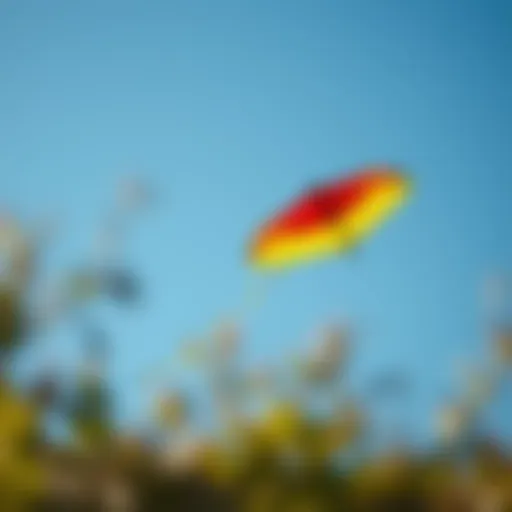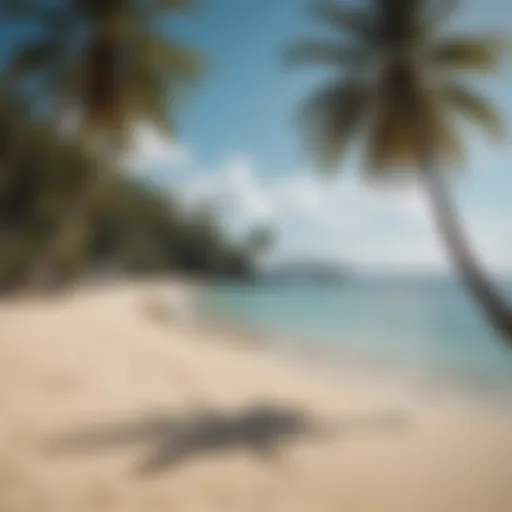In-Depth Look at Kitesurfing Foil Boards for All Levels
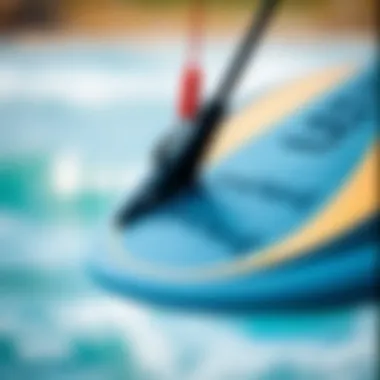
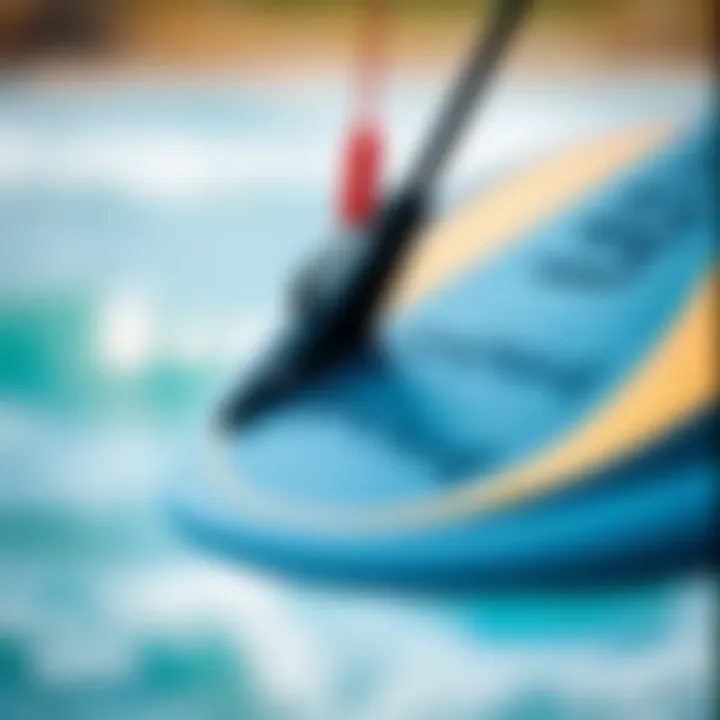
Intro
Kitesurfing has taken the water sports world by storm, and at the heart of this excitement lies the kitesurfing foil board. These unique designs have evolved with advancing technology, creating a thrilling blend of speed and agility on the water. For kiteboarders, understanding foil boards is not just about riding; it's about enhancing the overall kitesurfing experience. From beginners who are just getting their feet wet to seasoned pros pushing the limits, there’s much to grasp about these boards.
In this article, we’ll take a closer look at the design, functionality, and benefits of these boards. We will explore the technical aspects that contribute to a rider's performance while also covering the maintenance tips that can prolong the life of the gear. Additionally, we will analyze how environmental conditions can dramatically influence how a foil board performs, making it essential knowledge for any kiteboarder.
We'll start with the essential gear insights that every kitesurfing enthusiast should know. Buckle up, because this journey will be both comprehensive and enlightening!
Understanding Kitesurfing Foil Boards
Kitesurfing foil boards have ushered in a new era for water enthusiasts, particularly those who enjoy the thrill of riding the waves with a kite. Understanding these specific board types is crucial for both beginners and seasoned riders alike. The way these boards function and interact with water can drastically alter one’s experience on the water.
Foil boards lift above the water surface thanks to the foil attached underneath, allowing for a smoother ride and greater speed. As riders learn to navigate the foiling experience, they discover not only the excitement of flying above the waves but also the unique challenges that come with it. These boards offer numerous benefits which include the ability to ride in lighter wind conditions, enhanced agility, and a more exciting way to tackle waves.
Definition and Functionality
Kitesurfing foil boards are specialized boards equipped with a hydrofoil, which consists of wings that extend below the water's surface. This design allows the board to lift off the water as it gains speed, creating less drag. Essentially, the functionality lies in the ability to harness wind power while minimizing water resistance. For many kitesurfers, this means performing tricks and maneuvers that are more difficult or impossible with traditional boards.
Components of a Foil Board
- Board
The board itself serves as the foundation for the rider. Typically longer and thinner than traditional kitesurf boards, its shape is designed to accommodate foiling. The key characteristic of boards specifically designed for foiling is their lightweight composition, usually made from materials like carbon fiber or reinforced epoxy. This makes them much easier to control while flying above the water, making them a preferred choice in this article.
Unique features of foil boards include adjustable foot straps that can be fine-tuned for optimal rider comfort, allowing for better balance and performance. Some boards also come with a grooved surface to maintain grip even at high speeds, although they might sacrifice some stability compared to wide-bodied traditional boards.
- Foil
The foil is arguably the most critical aspect of a foiling setup, consisting of a mast, a front wing, and a rear stabilizer. Its main purpose is to provide lift. The design of the foil can greatly affect the riding experience. For example, a larger front wing enables easier takeoff and better stability, making it a popular choice for beginners. However, larger wings can also create more drag, which may be a disadvantage for experienced riders seeking speed.
Foils also come in varying shapes, each tailored for specific riding styles, whether it's enhancing speed, improving stability, or facilitating tricks. However, they can be costly and need regular maintenance to ensure optimal performance through methods like cleaning away salt and inspecting for wear.
- Kite
The kite serves as the powerhouse of a kitesurfing setup, providing the lift necessary to propel the rider forward. Kites come in different shapes and sizes, dictating how they interact with foils. For foil boards, a kite with a quicker response and better control is generally the most beneficial.
A unique feature of kites suited for foiling tends to be their lightweight design, allowing them to catch even the slightest breeze. This is especially advantageous when riders want to practice in lower wind conditions, making it much easier to get on the foil. On the downside, lighter kites can be less stable in stronger winds, requiring skill to handle effectively while foiling.
How Foil Boards Differ from Traditional Boards
Foil boards and traditional boards are like chalk and cheese; their functionalities cater to different riding experiences. Traditional boards operate primarily on the water's surface, whereas foil boards create a lift, permitting riders to glide above the water.
Riders will notice differences in speed and maneuverability as well. Foil boards often enable faster rides since they encounter significantly less drag. However, they also require a greater level of skill and experience to control effectively. This difference can lead to a steep learning curve, but once mastered, the experience is well worth the effort and practice.
The Science Behind Kitesurfing Foil Boards
Understanding the science behind kitesurfing foil boards is crucial for optimizing performance and ensuring thrilling rides. By comprehending the mechanics of lift, stability, and environmental factors, riders can make informed decisions about their gear and techniques, ultimately enhancing their experience on the water. This segment of the article delves into the fundamental principles that govern kitesurfing foil boards—integral knowledge for kiteboarders eager to push their limits.
Hydrodynamics and Lift
At the core of kitesurfing foil board performance lies the principle of hydrodynamics—the study of fluids in motion. When a foil board is in use, the hydrofoil creates lift by interacting with water as it glides. The shape of the foil, its angle of attack, and the speed at which the board travels all play pivotal roles in generating this lift.
The foil features a wing-like shape designed to manipulate water flow. As the board accelerates, water moves over and under the foil's surface. This setup leads to lower pressure above the wing and higher pressure beneath it, effectively lifting the board off the water's surface. This phenomenon significantly reduces resistance, allowing for smoother ascents and enhanced speed, further reinforcing the need for riders to understand their equipment's design.
To maximize lift, it's essential to adjust one’s foot positioning and weight distribution, considering how each slight movement can alter the foil's angle and, consequently, its performance. So, a rider's weight should shift subtly based on the wind's strength and water conditions, fine-tuning the lift generated by the foil.
"The way a foil interacts with the water can make or break your ride. Getting the hydrodynamics right is half the battle."
Foot Position and Balance
Proper foot position and weight distribution are vital to mastering the balance on a kitesurfing foil board. Unlike traditional boards, where a more centered stance can suffice, foil boards necessitate a more nuanced approach.
Achieving a balanced rider position may involve the following factors:
- Foot Placement: Placing feet closer to the tail enhances control during turns, whereas positioning them further forward may facilitate smoother takeoffs.
- Weight Management: Engaging the front foot can assist in keeping the board level while reducing the risk of nose-diving upon acceleration.
- Knees and Core Engagement: Keeping knees slightly bent and using core strength allows for greater stability and responsiveness when navigating waves.
Adjusting these elements can seem subtle, but it has a significant impact on the overall performance. Thus, practice is key, and finding equilibrium takes time, particularly in varying conditions. The ability to read the water’s surface and adapt one’s stance can often be the difference between a flawless glide and an unwanted fall.
Wind and Water Interaction
The interplay between wind and water is another essential aspect affecting kitesurfing foil boards. Riders must learn to gauge how wind patterns impact their speed and the foil's behavior on the water. Wind creates inertia that can either assist or hinder motion, necessitating continuous assessment of wind conditions from minute to minute.

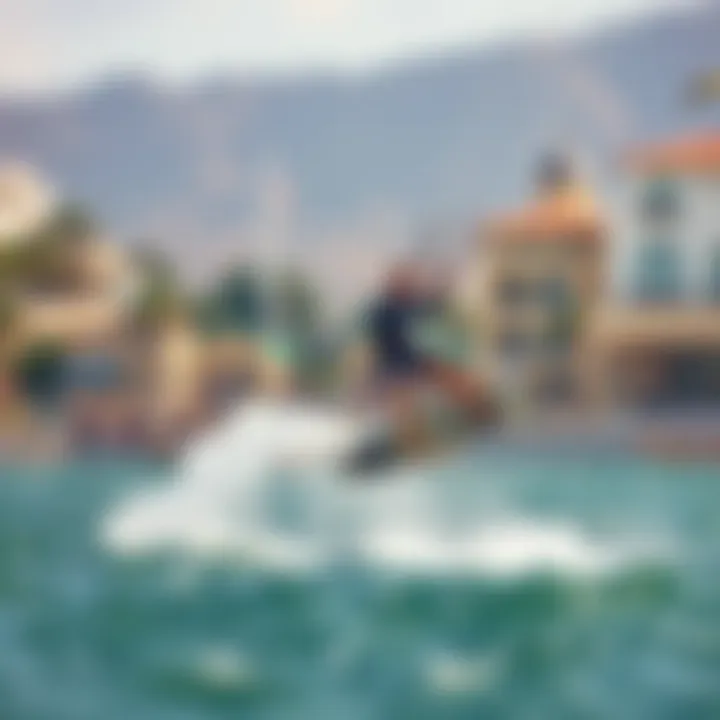
In terms of water interaction:
- Choppy Waters: These can lead to unexpected bumps and turbulence. In such scenarios, maintaining a low and steady center of gravity is beneficial for stability.
- Flat Water: Offers a different experience, allowing for bursts of speed and easier lift, enabling skilled riders to push the boundaries of their maneuvers.
The rider's awareness of these elements can inform decisions on when to deploy the kite and how to maneuver the board effectively. Therefore, becoming proficient in reading both wind and water is paramount for any kiteboarder aiming to take full advantage of what foil boards have to offer.
Choosing the Right Kitesurfing Foil Board
Selecting an appropriate kitesurfing foil board is crucial for enhancing your overall experience and performance on the water. A well-chosen foil board can boost your confidence, offer stability, and help you progress in your skills. This section delves into considerations for both beginners and advanced riders, ensuring you find the right fit that matches your unique style and requirements.
Beginner Considerations
Size and Volume
When it comes to kitesurfing, size and volume of the board play a pivotal role, especially for those just getting their feet wet. A larger board with greater volume provides added buoyancy, allowing beginners to start foiling easier and keep them balanced as they learn the ropes. This feature is particularly helpful when conditions aren’t perfect.
- Key characteristic: the added volume supports riders who may struggle with balance.
- Benefits: A big board helps beginners not just with learning how to balance themselves but also enables them to ride with less wind.
- Drawbacks: However, larger boards may feel cumbersome for some, making quick maneuvers less responsive. Therefore, selecting the size and volume should align closely with the experience level and personal comfort.
Stability Features
Stability is another critical aspect of choosing a foil board for beginners. Boards designed with wider profiles or a flatter bottom planform provide a stable base while riding. This creates a smooth learning curve.
- Key characteristic: the ability to remain steady even in choppy waters can instill confidence in novice riders.
- Benefits: Increased stability can mitigate the risk of falling, allowing for longer rides without interruptions. This is especially beneficial in variable wind conditions.
- Drawbacks: Boards that prioritize stability might sacrifice some maneuverability, which can hinder progression as the rider becomes more experienced and seeks agility in their control.
Advanced Rider Features
Performance Specifications
When riders reach advanced levels, performance specifications become significantly more important. Key metrics like aspect ratios, weight distribution, and materials begin to play a major role in a rider’s ability to execute high-performance tricks and maneuvers. An advanced rider may look for boards with a higher aspect ratio because they offer better upwind performance and require less surface area on the water.
- Key characteristic: High-performance boards often combine lightweight materials with specialized design to enhance speed.
- Benefits: This allows for rapid acceleration and improved handling, which is necessary for executing complex tricks.
- Drawbacks: However, boards focused on high-performance might be less forgiving for riders who are still smoothing out their technique.
Customizability
As riders refine their skills, customizability becomes increasingly valuable. Many advanced boards offer options like adjustable fins, pads, and straps, catering to personal preferences. This adaptability enables a rider to tune the board’s behavior to their liking, enhancing control and responsiveness.
- Key characteristic: Customizability allows riders to modify settings based on conditions or preferred riding style.
- Benefits: Adjusting various settings can help riders optimize their performance across different environments, making for a more versatile experience.
- Drawbacks: On the flip side, navigating the myriad of adjustments might overwhelm some, possibly causing confusion.
In summary, selecting the right kitesurfing foil board demands careful consideration of personal skill level, riding style, and preferences. Whether you’re a beginner needing stability and buoyancy or an advanced rider looking for performance and customization, understanding these aspects will pave the way for a more enjoyable experience on the water.
Environmental Factors and Performance
Understanding the connection between environmental conditions and the performance of kitesurfing foil boards is essential for both safety and enjoyment. Elements such as wind and water conditions can vastly influence how a rider interacts with their board, the speed they can achieve, and even their control during maneuvers. Navigating these factors effectively not only enhances the overall experience but also ensures that the kitesurfer remains within safe operational limits.
Wind Conditions
Wind conditions play a critical role in the overall success of a kitesurfing session. The importance of wind strength and consistency cannot be overstated. Ideally, the wind should be steady and within a range suitable for the rider's skill level and equipment.
When the wind is too strong, it may become challenging to control the kite, leading to potential accidents. Conversely, if the wind is too light, it may not provide enough power for the foil to lift above the water, resulting in a frustrating experience. Different kites, depending on their size and design, can also affect how wind conditions are handled. A larger kite will harness more wind, often proving beneficial in light winds, while smaller kites offer better control in stronger gusts. Judging the prevailing wind conditions and selecting the appropriate gear will help maximize performance.
Water Conditions
Water conditions encompass numerous elements that can dramatically affect the rider's performance, notably wave height and water clarity.
Wave Height
The height of the waves can greatly influence the dynamics of riding a foil board. Generally speaking, smaller waves permit smoother operations, while larger swells can add an extra layer of complexity. When riders encounter substantial wave height, they must be ready for the board to react differently.
A significant advantage of foiling in larger waves is the board's ability to glide above the water surface, decreasing drag and increasing speed. However, larger waves also pose challenges, such as the potential for loss of control during sudden drops or when transitioning between peaks. Riders looking to maximize their performance would do well to practice in various wave conditions, allowing them to become adept at handling whatever nature may throw their way.
- Benefits of suitable wave height include:
- Challenges to consider:
- Enhanced thrill during the riding experience.
- Opportunity for practicing jumps and tricks.
- Increased risk of wipeouts.
- Need for advanced control techniques.
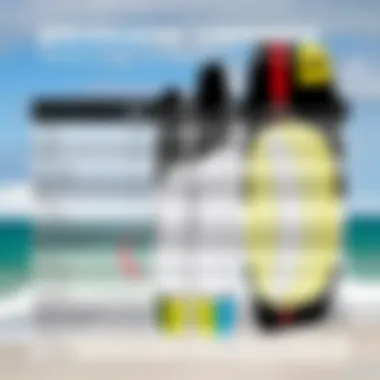
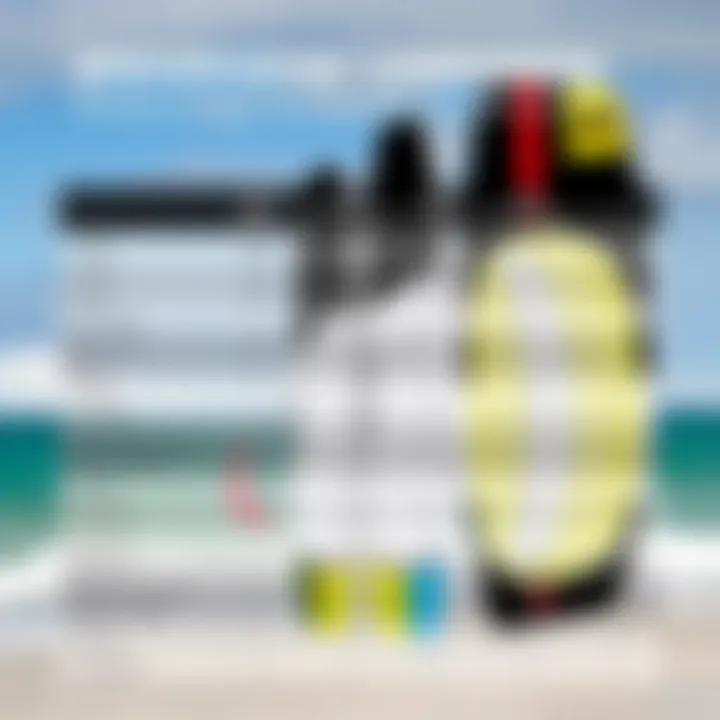
Water Clarity
Water clarity is another essential factor that contributes significantly to kitesurfing experiences. Clear waters can facilitate visibility which aids in avoiding obstacles and enhancing overall awareness during a session. In contrast, murky waters may pose challenges that can affect both safety and enjoyment.
A key aspect of water clarity is how it influences the rider's ability to gauge the underwater environment. In clear waters, one can spot rocks, reefs, or any marine life that may pose risks. This enhances the overall feeling of safety and control. In areas where visibility is limited, it’s wise to exercise greater caution. Clear waters also present a more pleasant aesthetic for riders, contributing to a more enjoyable sensory experience while riding.
- Advantages of good water clarity include:
- Considerations regarding less clear water:
- Improved navigation and awareness.
- Creates a scenic environment, enhancing enjoyment.
- Hidden obstacles may lead to accidents.
- Reduced visual enjoyment due to murkiness.
In summary, environmental conditions—specifically wind and water—are vital determinants of kitesurfing foil board performance. A keen understanding of these factors empowers riders with the knowledge needed for safer and more enjoyable sessions.
Safety Considerations for Kitesurfing with Foil Boards
Kitesurfing with foil boards offers an exhilarating experience, but it also brings with it certain safety challenges that all enthusiasts should be mindful of. The thrill of gliding over the water, lifted by the power of the wind, can sometimes overshadow the very real dangers present in the sport. By understanding and prioritizing safety considerations, riders can enhance their enjoyment while minimizing the risks associated with this dynamic activity.
Essential Safety Gear
Lifesavers and Wetsuits
When it comes to safety in kitesurfing, lifesavers and wetsuits are non-negotiables that every rider should have. Lifesavers, such as buoyancy aids, provide crucial flotation should one find themselves in difficulty. Meanwhile, wetsuits not only keep the body warm in cold waters but also offer a layer of protection against wounds or scrapes from falls or contact with the board.
A prominent feature of a wetsuit is its insulating property – it keeps core body temperatures stable even in frigid waters. The lining, generally made from neoprene, is flexible yet forms a snug fit, allowing for freedom of movement combined with warmth. For kitesurfing, opting for a wetsuit with a thicker material can be beneficial, particularly during colder seasons. However, it’s essential to balance warmth with flexibility to prevent restrictions in movement while navigating the foil.
"Wetsuits are more than just an extra layer; they can mean the difference between a thrilling session and a risky one."
Helmets and Impact Vests
Alongside lifesavers and wetsuits, helmets and impact vests are vital components for ensuring rider safety. Helmets protect against head injuries from unexpected falls or collisions, which can be consequential at high speeds and with the unpredictable dynamics of kiteboarding. Look for designs that are lightweight, yet offer robust protection and good ventilation to avoid overheating during intense riding.
Impact vests, similar to what surfers wear, provide cushioning for the chest and back, mitigating the impact of falls. These often come with added buoyancy, enhancing overall flotation. However, some riders may feel constrained by the bulk of vests, which can potentially restrict movement during maneuvers. Thus, selecting a vest that prioritizes comfort and fits well is crucial.
Common Hazards and Mitigation Strategies
Despite taking necessary precautions, hazards abound in kitesurfing. Common hazards include strong currents, sudden wind changes, and crowded waters. To mitigate these risks, it’s essential to understand your environment and the forecast. Riders should avoid kitesurfing in stormy conditions or areas densely populated with other water users.
- Stay Within Your Skill Level: Beginners should not overextend into more challenging conditions or locations. Knowing one’s limits can be life-saving.
- Check Equipment Regularly: Ensure that all gear is in good condition and free from defects that could lead to accidents. A well-maintained kite, board, and safety gear can prevent mishaps.
- Practice Emergency Procedures: Familiarizing oneself with emergency protocols, such as how to signal for help or how to safely self-rescue in case of gear failure, can make a significant difference in urgent situations.
As thrilling as kitesurfing is, it’s crucial to recognize the importance of these safety considerations. With the right setup and precautions in place, riders can focus on enjoying the ride – whether it’s their first attempt or they’re seasoned pros.
Maintenance Tips for Foil Boards
Maintaining your kitesurfing foil board is not just about keeping it clean; it plays a fundamental role in enhancing the board’s performance and lifespan. These boards, while built to endure various conditions, require regular attention to ensure safety and efficiency on the water. Neglecting maintenance can lead to diminished experience, increased repair costs, and ultimately, a compromised safety on the waves. In this section, we’ll discuss essential cleaning practices, inspection routines, and optimal storage methods that can help prolong the life of your foil board.
Cleaning and Inspection
Cleaning your foil board is a straightforward yet crucial part of maintenance. After a session, saltwater, sand, and other debris can accumulate, affecting both the aesthetics and functionality of the board. A simple rinse with fresh water is often enough to remove these residues. Ensure you pay particular attention to areas where dirt tends to cling, such as the base of the foil mount and the board's edges.
- Steps for Cleaning:
- Rinse the board with fresh water immediately after use.
- Use a soft sponge or cloth to gently scrub any stubborn spots without scratching the surface.
- Dry the board completely to prevent any corrosion or mold from developing.
In addition to regular cleaning, conducting periodic inspections is vital. Check for signs of damage, such as scratches, cracks, or delamination. It’s all too easy to overlook minor issues that can escalate into significant problems. Focus on the following when inspecting:
- Foil Attachment: Ensure the mounts are not loose or corroded, as securing a foil improperly can lead to dangerous situations when riding.
- Board Integrity: Look for any soft spots or discolored areas, which can indicate water ingress.
Regular cleaning and inspection not only keeps your board looking new but also ensures it performs at its best.
Storage Recommendations
How you store your foil board is just as critical as how you care for it. Proper storage can prevent warping and damage, leading to a more reliable performance over time. Here are key tips to consider when storing your board:
- Choose the Right Location: Keep your foil board in a cool, dry place away from direct sunlight. Prolonged exposure to UV rays can degrade the materials over time. A dedicated rack or a board bag can be handy.
- Avoid Stacking: If you have multiple boards, avoid stacking them on top of each other, particularly if they’re still wet. Instead, consider storing them on a vertical rack to allow proper air circulation.
- Temperature Control: Temperature fluctuations can affect the materials used in your board. Try to store it in a climate-controlled area if possible. Extreme temperatures may warp the board structure.
Following these maintenance tips ensures your kitesurfing foil board remains a trusty companion during your adventures on the water, maximizing both your enjoyment and safety.
Comparing Different Brands of Foil Boards


In the vibrant world of kitesurfing, the choices for foil boards can seem as vast as the ocean itself. With a diverse array of brands and models on the market, selecting the right foil board becomes crucial for both performance and enjoyment. Understanding the differences among these brands is not only beneficial; it can make or break a rider's experience on the water. This section dives into the significance of comparing different brands of foil boards and highlights what factors one should consider when navigating this sea of options.
Top Brands and Their Offerings
When it comes to kitesurfing foil boards, several brands have built a reputation based on quality, performance, and innovation. Each company delivers its unique flavor, emphasizing various features tailored to different skill levels and riding styles. For instance:
- Naish: Known for its high-performance and durable boards, Naish integrates cutting-edge materials, catering to both beginners and seasoned riders.
- Slingshot: This brand often emphasizes adaptability and ease of use. Their boards are crafted for performance without sacrificing stability, making them a favorite among new riders eager to advance quickly.
- F-One: Offering a range of sizes and shapes, F-One is celebrated for its lightweight construction, which elevates the ease of maneuverability.
- Duotone: This brand offers advanced technology that allows riders to experience smoother rides even in choppy waters. Their boards cater to those looking to elevate their skills swiftly.
"Choosing the right brand can mean the difference between a memorable session and a frustrating day on the water."
These brands put significant thought into their offerings, considering materials, design, and technology. Paying attention to what each manufacturer focuses on can help kiteboarders find a board that aligns with their personal style or riding conditions.
Value vs. Performance Analysis
When comparing foil boards, one hot-button issue is the balance between value and performance. High-end boards often come with a hefty price tag, which raises the question: once you get past the sticker shock, are they really worth it? Here’s what to mull over:
- Materials Used: Cheaper boards might be made from lower-quality materials, which could affect durability and performance over time. While saving money is key, consider if it’s worth compromising quality.
- Warranty and Support: Established brands often provide solid warranties and customer support. Investing in a reputable brand may offer peace of mind should any issues arise.
- User Experience: Performance may vary depending on skill level. Beginners might prioritize stability rather than speed, and certain brands cater specifically to novice needs.
- Resale Value: Higher-end foils can maintain their value better if they are well cared for, making any initial investment more justifiable over time.
In summary, while some riders might lean towards affordability, others may find that a significant investment in performance pays off in the long run. Ultimately, understanding the balance between value and performance helps in choosing a foil board that won’t just fit your wallet, but also enhances your kitesurfing experience.
The Future of Kitesurfing Foil Boards
The kitesurfing scene is a dynamic environment, shifting as rapidly as the winds that empower the sport. Looking ahead, the direction of kitesurfing foil boards is equally captivating. Innovations in design, materials, and technology are redefining what riders can achieve on the water. Understanding the future of these boards not only excites enthusiasts but is essential for maintaining a competitive edge in this vibrant community.
Technological Innovations
In recent years, kitesurfing foil boards have witnessed an influx of technological advancements. These aren't just minor tweaks; they are groundbreaking developments that can transform the way kitesurfers experience the sport.
One notable innovation is the introduction of lightweight composite materials. Brands are increasingly employing carbon fiber and other advanced materials, which drastically reduce board weight while enhancing durability. Also, boards now feature improved hydrofoil designs. This may seem like small beans to the untrained eye, but a well-designed foil can dramatically change the lift during each ride.
Additionally, performance tracking systems are becoming more prevalent. These systems integrate GPS and other sensors to deliver real-time data on speed, altitude, and even wind direction. For riders looking to refine their skills, this data can be invaluable. The integration of smartphone apps brings forth a modern touch, allowing kitesurfers to analyze their performance post-ride and share it easily on social media, fostering a sense of community.
“As technology evolves, so does the joy of riding. Innovations are making the sport more accessible and thrilling.”
Another aspect to consider is the environmental impact of production materials. Companies are making strides towards sustainability, developing eco-friendly materials that do not compromise performance. Embracing greener practices not only enhances the industry's reputation but also attracts eco-conscious riders who are keen on preserving ocean ecosystems.
Predictions for the Sport's Evolution
Looking at the horizon, several trends are poised to influence kitesurfing foil boards significantly. One emerging trend is the ongoing cross-pollination of sports technologies. As kitesurfing continues to draw inspiration from other water sports like windsurfing and surfing, we may see integrations that combine elements from multiple disciplines. This could give rise to hybrid boards that are able to perform different functions, ideal for riders who want versatility.
Moreover, with advancements in artificial intelligence, personalized training regimes could become commonplace. Imagine using machine learning algorithms to analyze your riding style based on collected data, optimizing every aspect of your boards performance to tailor it just for you. This level of customization can elevate the kitesurfing experience, pushing limits that were once thought insurmountable.
As athletes like to say, keep your eyes open—competition will only intensify. With more brands entering the kitesurfing market, the race for innovation is heating up. This pushes established brands to stay on their toes and continuously innovate to keep their loyal customer base.
Finally, as the sport grows, so does the community around it. Kitesurfing events, schools, and online platforms are creating an expansive network for learning and sharing experiences. Creating safe spaces for learning while fostering an inclusive environment will drive the sport’s popularity.
In sum, while it’s impossible to predict with certainty, the future of kitesurfing foil boards looks extremely bright. Innovations in technology, eco-friendliness, and enhanced community engagement are just a few elements that mark the next chapters for riders across the globe.
Community and Culture Around Kitesurfing
The community and culture surrounding kitesurfing play an essential role in shaping the sport, ensuring it remains vibrant and accessible for enthusiasts of all levels. This shared passion not only bonds kiteboarders but also fosters a supportive environment that encourages learning, growth, and camaraderie. Whether through local gatherings or global events, the connections formed within this culture enrich the experience of kitesurfing vastly.
One of the most potent aspects of the kitesurfing community is its inclusivity. Participants come from varied backgrounds, ages, and skill levels, creating a melting pot of ideas and experiences. This diversity helps cultivate a welcoming atmosphere. No matter if you are a seasoned pro or a newbie struggling to get your balance, you will generally find a helping hand nearby, ready to offer tips or share stories of their own learning curves.
"In the end, it's not the skill alone that forms a great kiteboarder but the friendships made along the way."
Moreover, with the rise of social media and online platforms, the community has extended beyond physical borders. This expansion has facilitated a greater sense of belonging for many, as kiteboarding enthusiasts can now connect with each other from the comfort of their homes. It allows for sharing experiences, asking questions, and exchanging advice, encouraging constant improvement and enabling kiteboarders to adapt to new challenges more easily.
Kitesurfing Events and Gatherings
Events like competitions, festivals, and casual meet-ups serve as vital gatherings for the kitesurfing community. Not only do these events provide a stage for showcasing talent, but they also represent an opportunity to learn from the best in the sport. It's common to see legends of the sport sharing their wisdom through workshops, where folks can gain insights into techniques that they might not have learned elsewhere.
- Beach parties: Often integrated with local kitesurfing events, these gatherings are great for socializing, sharing tips, and enjoying some downtime after a day on the water.
- Competitions: These range from small local competitions to global championships, attracting top riders and enthusiastic audiences, fostering a sense of competition and motivation.
- Festivals: Organized around kitesurfing, festivals often include activities such as music, food, and demonstrations, providing a festive atmosphere that celebrates the sport.
These events do more than entertain; they serve as platforms for community bonding, strengthening ties, and creating shared memories that many kiteboarders cherish.
Sharing Knowledge: Forums and Social Media
Forums and social media platforms are treasure troves for kitesurfers looking to enhance their skills or find solutions to common problems. Websites like Reddit or specialized forums allow users to post inquiries, share their experiences, and discuss gear recommendations. The format encourages interaction, making it easier to receive feedback and advice from fellow kiteboarders.
Additionally, platforms like Facebook or Instagram play an instrumental role in event promotion, allowing event organizers to reach a broader audience. These channels allow users to showcase their tricks and techniques, inspiring others to push their limits. The visibility gained through social media not only enhances individual profiles but also promotes the broader culture of kitesurfing.
In addition to riding together, many kiteboarders often form lifelong friendships online. They might join groups where they can engage in lively discussions, share techniques, or even organize trips abroad to discover new kitesurfing hotspots.





